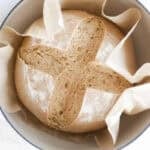Einkorn Sourdough Bread
Einkorn sourdough bread makes the most delicious bread. A wonderful fluffy, chewy interior and a satisfying, crusty exterior.
Servings: 12
Ingredients
- 3 cups all-purpose einkorn flour
- 1 cups whole grain einkorn flour or more all-purpose einkorn
- 1 1/4 cups water
- 1 cup sourdough starter
- 1 1/2 teaspoons salt
Instructions
- Feed your sourdough starter 4-12 hours before starting your dough. You want your starter bubbly and active for this recipe.
- Grind einkorn berries, if needed. Skip this step if you have pre-ground flour.
- Add flour and salt to a large bowl and mix.
- Add sourdough starter and water to the flour mixture and combine with your hands until it comes together. Let rest for 15 minutes.
- Flatten out the dough, then stretch out each edge and fold them back in on all sides. Roll into a ball. Place in a greased bowl and cover with plastic wrap or beeswax wrap. If the dough is sticky, dampen your hands before working with it rather than adding more flour. Allow to rest again for 20 minutes.
- Repeat the flattening and folding process. Allow to rest again for 20 minutes.
- Repeat the process another time, then shape and cover with plastic wrap. Allow to rise until doubled in size, about 3-12 hours, depending on the temperature of your home.
- Shape the loaf with your hands. Place it in a floured banneton basket. Cover with plastic and place in the fridge overnight. I usually use a plastic grocery bag and tie it shut to help keep it more air-tight.
The Next Day
- Preheat the oven to 450 degrees, allowing the Dutch oven to preheat for 30 minutes to an hour.
- Once the Dutch oven has preheated, take the dough out of the fridge and place it onto a sheet of parchment paper.
- Score the top of the dough and gently place the parchment paper and dough into the Dutch oven, cover with a lid, and place in the hot oven.
- Bake for 30 minutes with the lid, then remove the lid and bake for another 15 minutes until golden brown. Allow to cool before slicing.
Notes
- If you want to ensure your bread is 100% einkorn, start your sourdough starter with einkorn flour, or convert your current starter to einkorn flour. More information is in the FAQs in the blog post.
- Einkorn dough tends to be much stickier than regular bread dough. I like to use dampened hands and a bench scraper to combat this without having to add extra flour.
- When using a sourdough starter, it is recommended to use filtered water. Some water may contain too much chlorine, which can kill the beneficial bacteria and yeast in your starter.
- For the best rise and the perfect texture, I incorporated a modified stretch and fold process like with my other no-knead sourdough bread recipe. Since einkorn doesn’t have the same type of gluten structure, the process looks a little different but still yields a wonderful result that is light and airy.
- If you do not have a banneton basket, you could use a piece of parchment paper. Place the dough on the parchment paper, place in a bowl, and cover to rise.
- Set the dough in a warm place to facilitate a speedier rise.
- I like to use both whole-grain einkorn flour and all-purpose einkorn flour. I found this combination to be best for a soft and structured crumb. You can substitute the whole grain einkorn for more all-purpose flour if that is what you have on hand.
Nutrition
Calories: 203kcal | Carbohydrates: 43g | Protein: 6g | Fat: 1g | Saturated Fat: 0.1g | Polyunsaturated Fat: 0.3g | Monounsaturated Fat: 0.1g | Sodium: 293mg | Potassium: 94mg | Fiber: 3g | Sugar: 0.2g | Vitamin A: 1IU | Calcium: 11mg | Iron: 2mg
